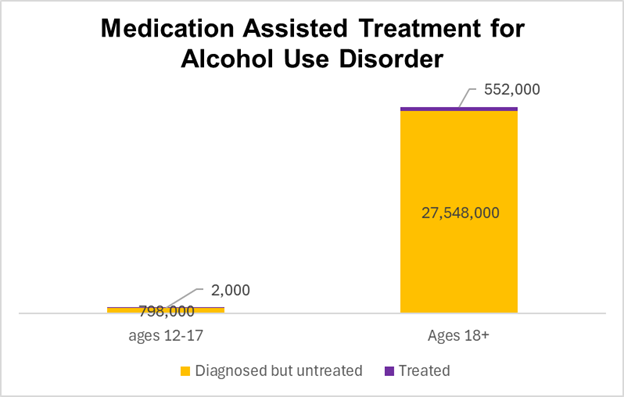Source: National Institute of Alcohol Abuse and Alcoholism, 2024 LINK
Alcohol use disorder (AUD) is common, affecting almost 11% of those over age 18 in the US. AUD is associated with premature mortality, including higher risk of death from cancer, liver disease, suicide, motor vehicle accident and violence. Alcohol use disorder is associated with a four to eight fold increase in workplace absence, and can contribute to workplace injuries. AUD is associated each year in the US with a total economic burden of $249 billion and 178,000 excess deaths annually.
There are three medications approved for treatment of alcohol use disorder. Naltrexone and acamprosate reduce craving, and disulfiram induces nausea, vomiting and flushing if someone consumes alcohol. All have been shown to reduce alcohol use.
However, drug treatment for alcohol use disorder is rare. Only 2% of adults with AUD receive medical therapy, and only 0.3% of adolescents with this diagnosis are treated medically (see figure above). All the drugs to treat AUD are available generically, and cost between $30-$60 per month (1) (2) (3). Vivitrol is an extended-release injection of of naltrexone which costs $1500-$2000 per monthly injection and is not available generically. While some with AUD remain abstinent by participating in Alcoholics Anonymous or Smart Recovery programs, some require medicine to maintain abstinence.
Implications for employers:
- Employers can train managers and supervisors to watch for signs of AUD, and to refer affected employees to Employee Assistance (EAP) programs or to get medical therapy.
- AUD is a common clinical condition, and managers and supervisors can seek to avoid stigma associated with this diagnosis. Some suggestions on how to do this are found on this CDC website.
- Managers and supervisors should also be aware that family members of those with AUD are more likely to miss work and might benefit from mental health support.
- Most pharmacy benefit manager formularies offer access to these AUD medications without prior authorization requirements.
- Many with AUD have difficulty gaining access to medical treatment. Carriers and EAP programs can help members navigate to effective treatment.



